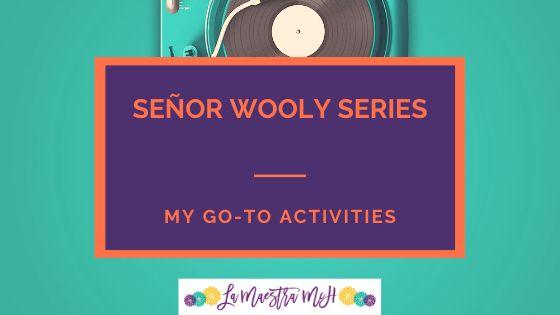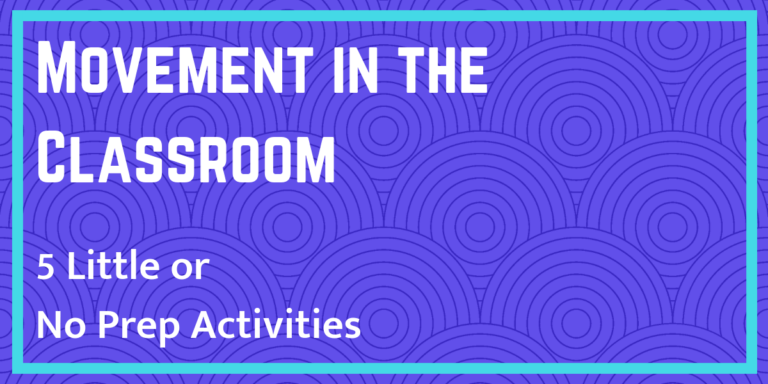Practicing the Alphabet & A Cultural Update
Teaching the Spanish alphabet to high school students, how to do it without it being too juvenile. That was my challenge when searching for Spanish alphabet practice activities. I needed something appropriate for my students’ ages (14-16) yet simple enough for their novice-low proficiency levels. My goal is that students are able to confidently spell their last names and understand words they hear spelled aloud. I created this Spanish alphabet listening practice for them.
I love it for a few reasons:
- It gets kids up and moving.
- It gets them asking questions in Spanish (¿Qué es letra dos?)
- It introduces them to the word qué
- It gives them a chance to say the letters aloud and listen to them
Initially I wrote five letter Spanish words my students don’t know on index cards. I chose words that my students won’t know so that they can’t guess the word before hearing all the letters. The cards are written in the following format:

I’ve since updated to printed, clearer versions of 5-letter and 6-letter words that include question scaffolding right on the card. When I first began I taped a card to each student’s back. This is awkward and time consuming. Pair up students and have them tape cards to each others backs so they can’t see it. You can also tape them to the back of a mini whiteboard or student notebooks/folders.

The classic version of this activity:
- Students walk around and ask their classmates, “¿Qué es letra uno?”, “¿Qué es letra dos?”, etc.
- They can only ask each person one letter.
- Students write the letters on white boards as they go.
- Once students have all the letters, they have to check with me to see if they are correct.
- If they are they will sit down and wait to swap cards for round two. It’s important to emphasize that they can still answer people’s questions.
For more structure:
- Do the same procedure as above but instead of freely walking around, use the two-line or inside/outside circle approach
- Students move and change partners for each letter when you signal them to move
- This is also makes it easy for students to swap cards with their final partner for the next round of practice
For whole class, paced practice:
- Pair up students, have them stand around the room with one person facing your projector and one looking way
- Project a sheet of words
- The students facing the projector spells the words to their partner who write them on a white board or paper.
- When done with all 4 words, partner switch places
- Pro-tip: Encourage groups to start in different places (top left, bottom right, etc) to avoid the echo effect of everyone spelling the same word.
- Make sure groups are spread out so they can only hear their partner.
- If you want, at the end of each round, spell the words aloud yourself to reinforce proper pronunciation of the alphabet.
Formative Alphabet Pronunciation Assessment
I teach in a 1:1 school so it would be easy for me to assign 4 words (1 page of cards) to a student and ask them to record themselves spelling the words via Flipgrid or turning in a video/audio file via our learning management system. This allows me to:
- hear individual student pronunciation
- provide recorded audio feedback to aid in pronunciation
- give personalized encouragement to my students
Station Use
Similar to the whole class paced practice, these make a great station.
- Students draw a card and spell the word to their partner
- Switch roles
- Alternatively, students draw a card and record a video of themselves spelling the word. Partners can film. You review the videos at a later time for formative assessment
Upper Level Use
An upper level twist I hope to implement is this: use words to introduce culture. Instead of writing common, random words, I’ll write culturally significant words such as “alebrijes”, “Botero”, “la guagua”, “mariachi”, etc. After figuring out what the word is, students will research the topic they have (I work in a 1:1 school where students bring their own devices. If you don’t, plan this activity on a lab day OR print starter articles for students to look at and head to the lab next class!). I’ll provide them a guide sheet with question to answer such as,
- What country or region is your topic affiliated with?
- What is your topic (arte, música, deportes, etc)
- Describe your topic using words you know (colors, adjectives, associated nouns like “paint”, “instruments”, etc)
- List two interesting/fun/surprising facts about your topic
- Find three more words in Spanish related to your topic
Students could make a quick presentation they share with groups then build upon, practice, and refine to share with the class. Shortened pecha kucha anyone? 🙂 Things I like about this twist to the original:
- Review the alphabet and spelling!
- Differentiate by giving students longer words or shorter words.
- If you know your kids well enough, give the soccer fan a famous player or team, give the student who loves art an artist. Help them expand their interests!
- Good intro to lots of different types of culture or you could focus on art or musicians or writers or athletes or scientists or natural features or…you get the picture.
If you’d like your own copy of ready-to-use Spanish alphabet cards, you can get them here!



This is a great idea!